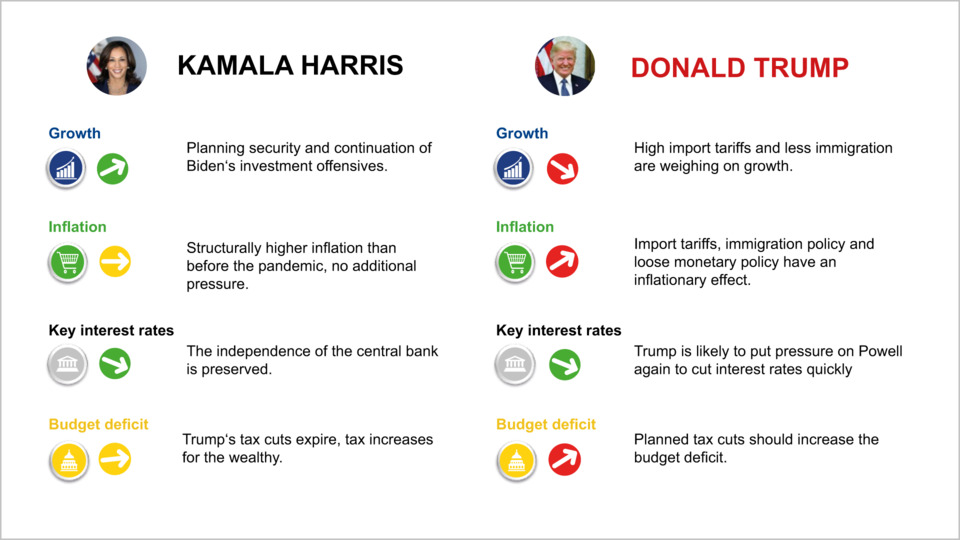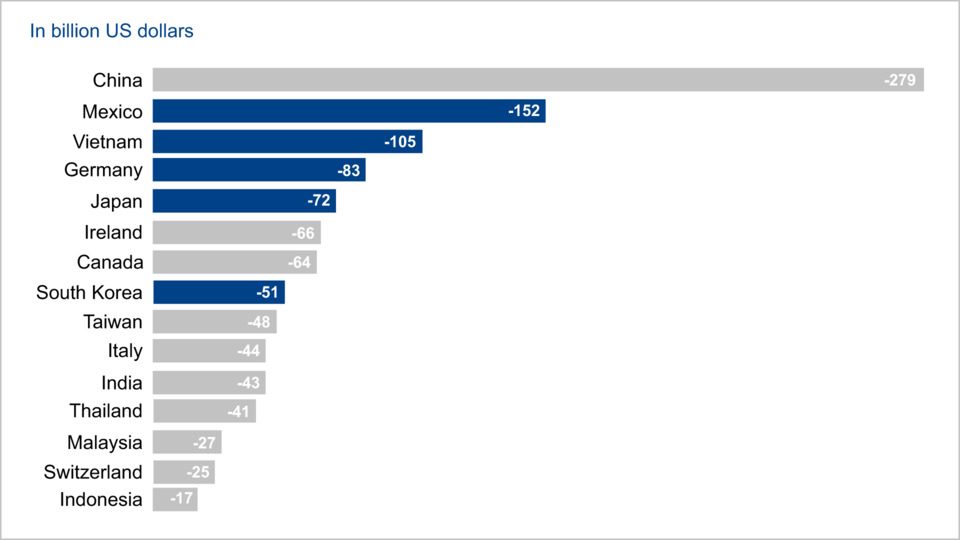專家「聯」綫:美國大選 - 對投資組合的最後啓示 (只提供英文版本)

|
On 5 November, the world will be looking eagerly to the US to see whether the 47th president or the first woman president will be moving into the White House. The election could have a significant impact on the economy and capital markets, and thus also on portfolio positioning.
One thing seems clear: the race for the White House is likely to be extremely close. At the moment, things are looking good for the Democratic Party's presidential candidate, Kamala Harris. She is narrowly ahead of or neck and neck with her Republican opponent, former President Donald Trump, in all the key states. But a lot can happen between now and the election in November, and the US electoral system has peculiarities that make forecasting much more difficult. After all, as past elections have repeatedly shown, it is not enough to win a majority of the votes; you also have to secure a majority of the so-called electors from the 50 states. Harris's chance is that a stable majority of Americans are against Trump. If she manages to get this majority to the ballot box, she will win.
Harris vs. Trump
Business as usual vs. far-reaching effects on the capital market environment

Source: Union Investment
With the first female president in US history, the consequences for the economy and capital markets should at least be easy to calculate. In many respects, Harris is likely to continue her predecessor's economic policy course. Among other things, this means that the extensive investment programmes such as Joe Biden's Inflation Reduction Act will be continued. In addition, the Democrat wants to focus on creating affordable housing. This should provide impetus for the US real estate industry. However, how Harris can implement her plans also depends on the majority situation in Congress. On 5 November, in addition to the presidential election, 34 of the 100 Senate seats and all 435 members of the House of Representatives will also be up for election. Currently, the Democrats have a narrow majority in the Senate and the Republicans in the House of Representatives. Here, too, shifts are conceivable that could either make it easier or more difficult to implement the administration's agenda.
The economic policy focus is on tax, trade and immigration policy.
Under a second Trump presidency, however, things could get restless. This is because it is likely to be even more unpredictable than the first term in office from 2016 to 2020. At that time, Trump was still surrounded by moderates who tried to prevent major missteps. This time, Trump's entourage consists almost exclusively of people who support him uncritically. To predict the economic policy consequences of the election, the three areas of tax, trade and immigration policy are crucial. Let's start with the latter: Trump wants to try to seal the borders and deport illegal immigrants on a large scale. This would have an immense impact on the labour market and the capital market environment. In particular, the construction industry, agriculture and the service sector, for example in the hospitality industry, are likely to face considerable problems.
Harris remains loyal to the line of her predecessor
With regard to tariffs, Kamala Harris is likely to broadly follow the line of her predecessor and also introduce further tariffs against China in selective, strategically important areas. Trump's plans, on the other hand, would mean a hard decoupling from China. The bilateral trade deficits are a thorn in his side. He is planning tariffs of 60 per cent on Chinese imports.
Bilateral trade deficits are still a thorn in Trump's side.
Trump continues to focus on bilateral trade deficits

Source: Union Investment
On top of this, there is the ban on the import of essential goods such as pharmaceutical or electronic products. Furthermore, Trump plans to impose tariffs of ten per cent on imports from other countries as well. These could be even higher for certain nations that the US believes are manipulating their currency. The third principle is reciprocity. In other words, Trump wants to see tariffs aligned in both directions. European car imports are often cited in the US as an example of unfair and unequal treatment. US exports are subject to a 10 per cent tariff in Europe, while the US tariff on European imports is only 2.5 per cent. Trump wants to change that. All in all, this would be a significant tightening of the status quo.
Trump uses import tariffs as a threat
To make matters worse, Trump usually uses tariffs initially as a threat to build pressure and force his negotiating partners to give in. This was already evident in his first term in office. However, the step was only moderately successful. If the tariffs are introduced, however, they will have a huge impact on prices in the consumer electronics segment, for example, which has not yet been directly affected by higher tariffs. From the consumer's point of view, a tariff has the same effect as a higher sales tax and means a price increase that particularly impacts low- and middle-income households. It will also be critical for companies that either produce a lot in China or generate a large share of their sales there. The latter would have to expect retaliatory measures from China. There are also tangible differences in tax policy. Among other things, Ms Harris's plans include tax relief for lower and middle-income earners, coupled with higher taxes for top earners and companies. Share buybacks would also be taxed more heavily. Mr Trump is taking a different approach: he wants to cut corporate taxes and extend tax breaks for top earners and the wealthy. Both plans would have a negative impact on the US fiscal deficit, but Mr Trump's would be significantly more drastic.
Immediate consequences for the capital markets
What impact would the respective measures have on the capital markets? With Kamala Harris as president, we are likely to see a rather unremarkable change of favourites on the stock market. For example, utilities and industrials could benefit as they would profit from continued infrastructure investments. However, there could be small short-term setbacks because Harris would not extend the corporate tax cuts that date back to Trump In the longer term, however, markets should benefit from stronger economic growth under Harris – if she gets the necessary majority in Congress.
With Trump, it would probably be the other way around. In the short term, the markets could rise because they expect Trump to deliver persistently low corporate taxes and further deregulation. In the longer term, however, there is a risk of a rude awakening. Under Trump, we expect dwindling economic growth, higher inflation and generally higher uncertainty.
Investment favourites change depending on the election result
In the medium to long term, the different economic policy plans are also likely to have an impact on the bond markets. Under Kamala Harris, a higher long-term interest and yield level is to be expected, which stems primarily from higher potential growth. The yield curve is likely to steepen because yields rise more at the long end of the curve due to higher debt and fiscal spending. Trump would not lead to diametrically opposed conditions, but to comparable ones – albeit for different reasons. Here, weaker growth would lead to lower interest rates at the short end, while higher deficits would push up the long end.
However, in principle we also see investment opportunities in both cases, for example in corporate bonds and in selected stocks on the equity market. The favourites will change depending on the election result. If Trump wins, companies that would benefit from tax cuts but would not be affected by the planned relocations of workers would be among the winners. If Harris wins, on the other hand, infrastructure and real estate groups, for example in the construction sector, could benefit from her plans – provided she finds a majority in US Congress.
All information, explanations and illustrations are as at 9 October 2024, unless otherwise stated.